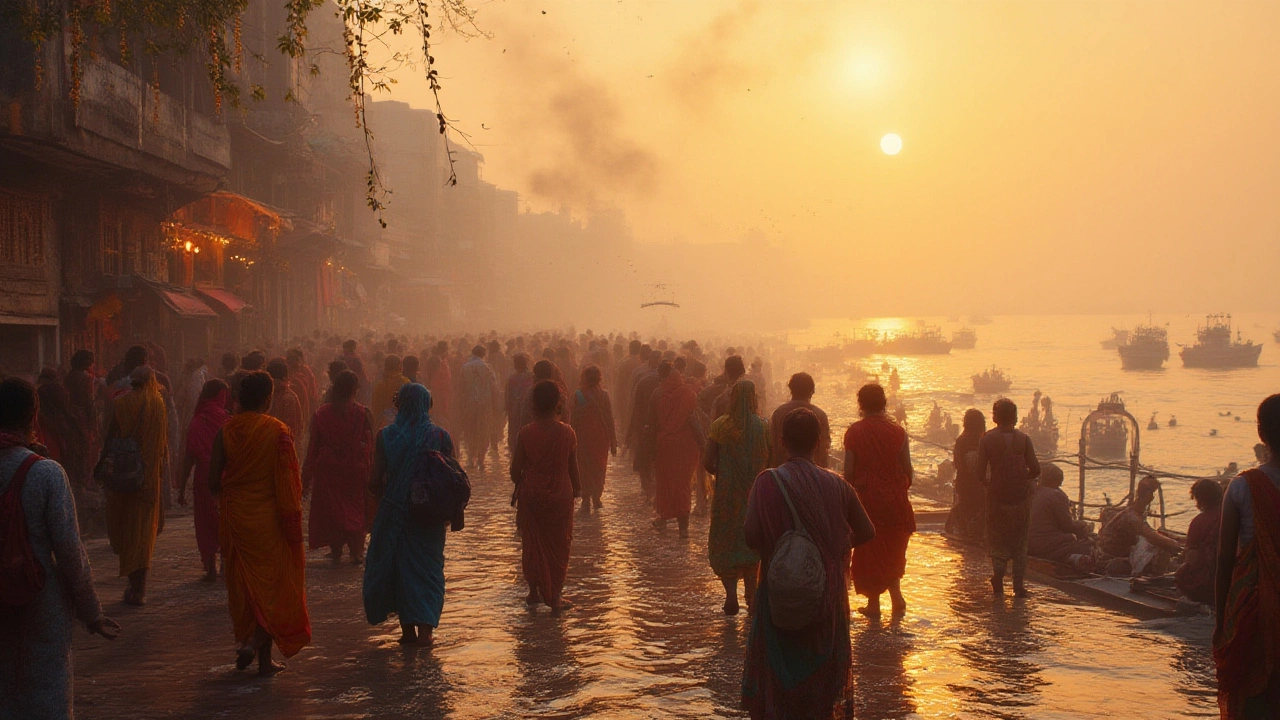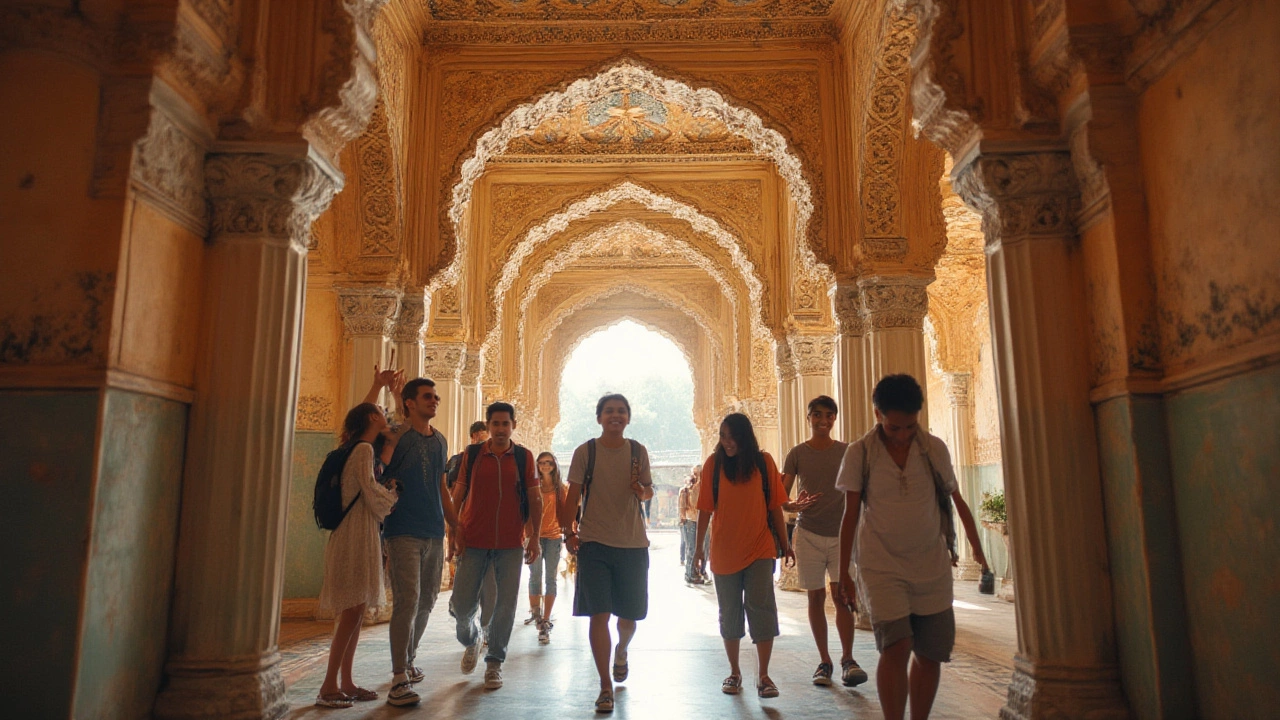Why Foreigners Love Traveling to India: Culture, Mystique & Adventure
 Jul, 28 2025
Jul, 28 2025
Why do so many folks from around the world find themselves drawn to India? The answer isn't just the Taj Mahal or spicy food—it's a mix of sensory overload, deep-rooted spirituality, ancient traditions, and wild unpredictability. Imagine landing in a country where one street can juggle a thousand years of history, high-tech startups, camels, monks, and cricket fanatics—all at once. Every time I feed Toby, my dog, he gives me the same look of confusion I had the first time I saw a holy cow blocking city traffic in Mumbai. India isn't for the faint-hearted, but that's exactly what makes it irresistible. Ready for a wild ride? Let's crack open the reasons that make India the global magnet it is.
Sensory Overload: The Land of a Thousand Experiences
No other place does sensory overload with as much flair as India. Your eyes jump from rainbow-color saris to turmeric-yellow rickshaws in traffic jams orchestrated by honks and temple bells. Right in the middle of New Delhi, you'll find centuries-old tombs rubbing shoulders with office complexes and street vendors selling samosas fragrant with cumin and coriander. The smells themselves could write a saga—spices in the morning, incense in the evening, hot chai bubbling at every corner. Indian markets don’t just sell goods—they sell chaos, adrenaline, and sometimes, a surprise foot massage from a passing goat. No joke.
Sounds are a serious business, too—here, silence is a rare animal. From megaphones that crackle in festivals to weddings blasting Bollywood hits at midnight, your ears never get bored. Foreigners often say that India wakes up every sense, including some you didn’t know you had. The simple act of crossing a street can feel like a video game. Even the weather is a patchwork: you can find frozen Himalayan peaks, burning deserts, and tropical rainforests, all in one country.
Food is another level—a literal journey across regions. A hungry traveler can have North Indian butter chicken for lunch, fiery Goan fish curry for dinner, and sweet Bengali rasgulla as a midnight snack. Most foreigners fall in love or regret it (temporarily) with street food, which comes with stories of both delight and digestive adventure. Hygiene standards can be, let's say, 'unpredictable,' so I'd advise: stick to busy stalls, stay hydrated, and always keep hand sanitizer handy. Local favorites like dosa, pav bhaji, and pani puri are a pocket-sized tour in themselves. And if you're a vegetarian? India’s your playground—over 30% of Indians are, too.
A quick look at key facts about India’s travel scene:
| Fact | Data/Stat |
|---|---|
| Foreign Tourist Arrivals (2024) | 12.7 million |
| No. of Recognized Languages | 22 official, 122 major |
| UNESCO World Heritage Sites | 42 |
| Vegetarian Population | 30-40% |
| No. of Recognized Festivals | Over 1,000 |
If you want to catch the magic, show up during a festival—think Holi’s color chaos or Diwali’s explosion of lights. Both are neighborhood-sized block parties open to everyone. Just check local calendars so you don’t miss out. And one pro tip: pack not just a camera, but a sense of humor and a wide-open mind.
Cultural Depth: Where Ancient Meets Unfiltered Modernity
India’s culture is onion-layered. The past clings to the present in odd and beautiful ways. Pilgrims trek thousands of miles to ancient temples one day, while local teens record TikToks in front of them the next. There’s the soft shuffle of priests chanting in Sanskrit, and there’s rush-hour metro madness, all in earshot. Most travelers get sucked into this time warp, where centuries spin together and nothing is ever quite as you expect.
Foreigners often come craving spiritual experiences, and India serves them on a dramatic scale. Varanasi, for instance, is the world’s oldest living city—imagine 3,000 years of prayers ringing out by the Ganges every sunrise. If yoga’s your thing, Rishikesh is the official Yoga Capital of the World, with ashrams lining the riverbanks. You can join a silent meditation retreat or get roped into a roadside cricket match when your thoughts get too quiet. India treats spirituality as a buffet. Hinduism, Buddhism, Sikhism, Jainism: they all dance together here, often sharing public holidays or temple grounds. Even skepticism is welcome—nobody minds if you meditate one day and Netflix-binge the next.
What hooks many Westerners? The chance to escape routines. There’s a sense that rules are flexible. Trains run late, banks close midday, strangers invite you to their brother’s wedding even if you met five minutes ago. Some travelers are shocked (and maybe a bit terrified) by how up-close-and-personal everyone is. In most Indian families, privacy’s just a suggestion—the line between 'me' and 'us' is thinner. But this openness quickly flips into the warmth that makes first-time visitors feel at home.
Art and architecture are everywhere: temples carved with dancing gods, Mughal palaces gleaming under the sun, villages with walls painted in colors nobody outside Crayola ever dreamed up. Bollywood films and songs are national glue, shared across all ages and classes. Want to fit in? Learn a couple of Shahrukh Khan movie lines and you’re halfway there. Even cricket—the country’s favorite sport—feels like a folk festival every time there’s a big match on TV.
Here’s a useful tip: while big cities overwhelm some, smaller towns slow things down. Places like Hampi or Udaipur offer cultural depth without sensory burnout. Try to buddy up with a local family, or join a walking tour—stories come alive when someone explains the logic behind temple bells or street rituals. If you’re after souvenirs, check out artisan co-ops or government emporiums. You'll find handwoven textiles, silverwork, and pottery—even the fakes are charming.

Myth, Mystique, and Modern-Day Adventure
Mystique is everywhere: India’s where the idea of snake charmers and yogis started. But legends aren’t just stories—they’re alive. In Rajasthan, stories of warrior queens and camel caravans stitch the desert together. In Kerala, houseboats drift through backwaters like a dream sequence. Foreigners love this constant sense of mystery—that you never see all of India, just the layer you’re ready for.
Plus, adventure travel here is intense. Trekking the Himalayas rivals anything in Nepal—check out Ladakh or Sikkim if you crave thin air and endless mountain horizons. Whitewater rafting on the Ganges, camel safaris in Jaisalmer, or exploring remote wildlife parks for tigers—there’s serious adrenaline beneath the romantic surface. If you want to keep it tamer, train journeys like the Palace on Wheels let you live out royal fantasies in wood-paneled cars while sipping chai.
Solo travelers find India both tricky and liberating. Public transport can make or break anyone’s patience, but the conversations you’ll have while waiting can be the best stories you bring back. There’s an unspoken backpacker network—a culture of helping each other, swapping survival hacks, and sharing everything from debit cards to ginger tea.
For women solo travelers, India takes planning. The country is safe in most spots, but cultural attitudes can be jarring. Conservative dressing (shoulders and knees covered), traveling in groups at night, and picking women-only train compartments help. Mobile apps and helplines make it easier now than ever before. For any solo adventurer, common sense outweighs any advice you’ll find in a guidebook.
But ask any foreigner stuck here longer than planned, and they’ll say: India gets under your skin. It’s unpredictable but never boring. It tests your limits, then rewards you with kindness in the weirdest places—a chai-wallah who remembers your order, an auto-rickshaw driver who becomes your city guide by default. Things break, plans shift, but memories thicken the more you surrender to the ride. And if things go really off the rails, just blame Mercury in retrograde—locals will laugh and instantly relate.
Extra adventure tip: Always have small change, a local SIM card, and a backup for Google Maps. Trains sometimes have their own sense of time, so be early, but bring snacks. And never skip a visit to an Indian chai stall—the banter is free, the insights are gold.
How to Experience India Like a Local: Practical Tips & Insider Advice
If you want the real deal, skip the all-inclusive hotels and try homestays or hostels. Best memories come from surprise invitations—join a local family for dinner, or accept that random temple festival invite. Indians are famously hospitable; most guests are treated like celebrities, even if you forgot to take your shoes off at the door. (Just don’t say no to chai—refusing a second cup is practically a diplomatic incident!)
Public transport is the best way to get around if you want stories, but it’s rarely smooth. The trains are epic: they crisscross 123,000 kilometers of rail lines, second only to China. Try booking long-haul routes early (using websites like IRCTC), and always double-check which ‘class’ you’re riding. Buses go everywhere, even if windows don’t always close. For city travel, use autorickshaws or app taxis like Ola or Uber—haggling is tradition, but apps save you from the worst shocks.
English is widely spoken, but learning “namaste” (hello) and “shukriya” (thank you) goes a long way. Indians appreciate effort and patience, especially when it comes to lines—queues are fluid, so keep your elbows sharp or your sense of humor sharper. Cash is still king in smaller towns, though tap-and-go cards are popular in cities. ATMs sometimes run dry during festivals, so stack up before big holidays.
Street food is a rite of passage but pick places packed with locals, and watch how they eat—locals have decades of practice avoiding tummy trouble. If offered water, politely ask for “bottled only”—tap water isn't always your stomach's friend. Download Google Translate and Maps; Indian addresses can be mysterious, and directions often come as “take a left at the banyan tree, then ask someone.”
Respect for religion matters. Before entering temples or mosques, always remove your shoes. Don’t point your feet at idols, and avoid public displays of affection near holy sites. Taking photos is usually fine but always ask. Tipping is expected in restaurants—around 10-15%, and round up for cab drivers or porters.
Power cuts, traffic jams, sudden downpours—embrace chaos as part of the fun. India moves on its own clock. If you miss a train or your plan fizzles, take it as a cue to discover something unexpected. That’s the India guarantee: the best stories are unscripted. And when you get back home, be ready—your suitcase will probably be stuffed, but your mind will be buzzing for months.
By the way, if you ever find a stray dog weaving through a temple fair, give him a friendly scratch behind the ears. It brings good luck. That’s Toby’s advice, anyway.